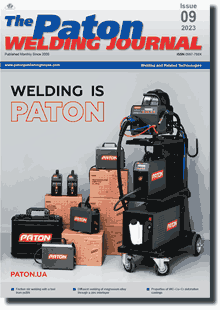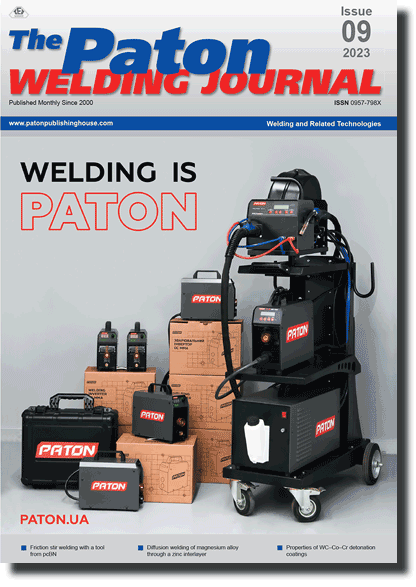| 2023 №09 (06) |
DOI of Article 10.37434/tpwj2023.09.07 |
2023 №09 (08) |

The Paton Welding Journal, 2023, #9, 43-46 pages
Improvement of the technology of manufacturing low-hydrogen agglomerated fluxes using fused materials
I.O. Goncharov, V.V. Holovko, A.P. Paltsevych, A.M. Duchenko
E.O. Paton Electric Welding Institute of the NASU.. 11 Kazymyr Malevych Str., 03150, Kyiv, Ukraine. E-mail: goncharovia@ukr.netAbstract
Gas chromatography method was used to study thermal desorption of hydrogen from mineral raw materials, used in manufacture of agglomerated welding fluxes. The good prospects for application of fused materials in the charge composition in agglomerated flux manufacture were established. Increase of fused material content in the composition of agglomerated flux charge leads to lowering of the flux susceptibility to sorption of environmental moisture. At increase of the content of fused material in the agglomerated flux charge from 15 up to 40% the diffusible hydrogen content in the deposited metal decreases from 3.5 to 2.6 cm3/100 g in submerged-arc welding with these fluxes. 12 Ref., 2 Tabl., 3 Fig.
Keywords: hydrogen, automatic arc welding with agglomerated fluxes, low-alloy steels
Received: 19.06.2023
Accepted: 09.10.2023
References
1. Morrison, W.B. (2000) Past and future development of HSLA steels. HSLA steels. Beijing The Metallurgical Industry Press.2. Komizo, Yu-ichi. (2006) Progress in structural steels for bridge and linepipe. Transact. of JWRI, 1, 1-7.
3. Poznyakov, V.D. (2023) Welding technologies for repair of metal structures. Kyiv, PWI [in Ukrainian].
4. Tianli, Zhang, Zhuoxin, Li, Frank, Young et. al. (2014) Global progress on welding сonsumables for HSLA steel. ISIJ Intern., 8, 1472-1484. https://doi.org/10.2355/isijinternational.54.1472
5. Poznyakov, V.D. (2017) Welding technologies for production and repair of metal structures from high-strength steels. Visnyk NANU, 1, 64-72 [in Ukrainian]. https://doi.org/10.15407/visn2017.01.064
6. Golovko, V.V., Potapov, N.N. (2010) Peculiarities of agglomerated (ceramic) fluxes in welding. Svarochn. Proizvodstvo, 6, 29-34 [in Russian].
7. Pokhodnya, I.K. (2003) Welding consumables: State-of-theart and tendencies of development. Ibid., 6, 26-40 [in Russian].
8. Bublik, O.V. )2009) Advantages and disadvantages of agglomerated (ceramic) fluxes in comparison with the fused fluxes of identical purpose. Ibid., 2, 27-30 [in Russian].
9. Golovko, V.V. (2012) Agglomerated fluxes in local welding production (Review). The Paton Welding J., 2, 33-35.
10. Goncharov, I.O., Holovko, V.V., Paltsevych, A.P. et al (2023) Technologies for producing low-hydrogen fused fluxes. The Paton Welding J., 7, 37-42. https://doi.org/10.37434/tpwj2023.07.05
11. Pokhodnya, I.K., Yavdoshchyn, I.R., Paltsevych, A.P. et al. (2004) Metallurgy of arc welding. Interaction of metals with gases. Kyiv, Naukova Dumka [in Ukrainian].
12. ISO 3690:2018 Welding and allied processes - Determination of hydrogen content in arc weld metal.
Suggested Citation
I.O. Goncharov, V.V. Holovko, A.P. Paltsevych, A.M. Duchenko (2023) Improvement of the technology of manufacturing low-hydrogen agglomerated fluxes using fused materials. The Paton Welding J., 09, 43-46.The cost of subscription/purchase order journals or individual articles
| Journal/Currency | Annual Set | 1 issue printed |
1 issue |
one article |
| TPWJ/USD | 384 $ | 32 $ | 26 $ | 13 $ |
| TPWJ/EUR | 348 € | 29 € | 24 € | 12 € |
| TPWJ/UAH | 7200 UAH | 600 UAH | 600 UAH | 280 UAH |
| AS/UAH | 1800 UAH | 300 UAH | 300 UAH | 150 UAH |
| AS/USD | 192 $ | 32 $ | 26 $ | 13 $ |
| AS/EUR | 180 € | 30 € | 25 € | 12 € |
| SEM/UAH | 1200 UAH | 300 UAH | 300 UAH | 150 UAH |
| SEM/USD | 128 $ | 32 $ | 26 $ | 13 $ |
| SEM/EUR | 120 € | 30 € | 25 € | 12 € |
| TDNK/UAH | 1200 UAH | 300 UAH | 300 UAH | 150 UAH |
| TDNK/USD | 128 $ | 32 $ | 26 $ | 13 $ |
| TDNK/EUR | 120 € | 30 € | 25 € | 15 € |
AS = «Automatic Welding» - 6 issues per year;
TPWJ = «PATON WELDING JOURNAL» - 12 issues per year;
SEM = «Electrometallurgy Today» - 4 issues per year;
TDNK = «Technical Diagnostics and Non-Destructive Testing» - 4 issues per year.


